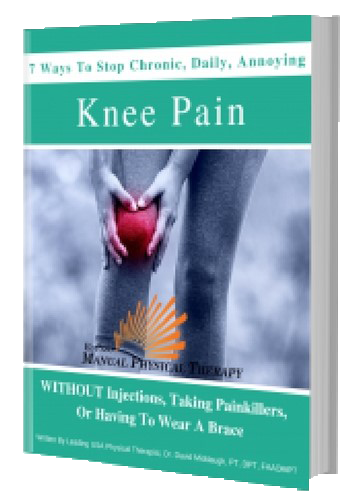TAP TO CALL (915) 503-1314

WHY UNDIAGNOSED KNEE ARTHRITIS IS TO BLAME FOR YOUR PAINFUL BAKER’S CYST
Undiagnosed knee arthritis is to blame for your painful Baker cysts. A baker cyst is pain and puffiness or swelling on the back of the knee. It’s also called a popliteal cyst, because the region in the back of the knee is called a popliteal fossa. So if you have any puffiness or swelling back there, your doctor might tell you that you have a popliteal cyst, but it’s most commonly called a baker cyst, and that everyone experiences knee arthritis the same way.
For some people, the first sign they get is actually a baker cyst. But not everyone in the healthcare profession connects the two. In this video, I’m going to build a case why a Baker says is really the beginning of knee osteoarthritis. And the first point I want to make is that both knee arthritis, osteoarthritis and a baker cyst have the same root problem.
They’re both rooted in muscle imbalances. Now, the muscle imbalance that is commonly causing this is when the quads right here in the front of the thigh, they start up in the hip and they run down to the knee, those muscles are too dominant and strong. And because of their connections, they compress the knee joint and push all the surfaces together. And if you don’t take that pressure off, then bad stuff starts to happen.
Some people get cartilage damage, a lot of stiffness. And some people don’t get that right away, they eventually get it but they get a Baker says first and what a baker cyst is, it’s swelling that appears on the back of the knee, it feels like a like a bubble. It’s usually puffy and soft, and it can often be very painful. And that happens as a result of an excessive amount of fluid buildup inside the knee that pops out on the backside of the knee.
Because there’s no bones in the way like there is in the front, there’s a kneecap and other ligaments and other structures. So it’s just the easiest space for extra fluid to move into that excessive fluid development happens as a result of a reaction of the inside of your knee joint to the excessive pressure build up from that muscle imbalance.
When those quad muscles on the front of the thigh that attach to the knee are putting excessive pressure over a sustained period of time, the knee joint has to respond some way for some people to get a breakdown of cartilage, meaning the arthritis but for other people, their cartilage holds out a bit, but starts to create extra fluid and that leads to the baker cyst.
In both cases, if you fix the muscle imbalance, then he can begin to take pressure off the knee joints and stop the excessive production of fluid that leads to the baker cyst, as well as stop the progression of knee arthritis and damages cartilage inside the knee joint.
Now people experienced knee arthritis differently some good a Baker says first and others get the classic signs of knee arthritis like stiffness, especially in the morning, or stiffness when they get up after they’ve been sitting for a while. Or they may just get swelling that’s around the knee joint, but not really on the back. It’s more on the inside the outside around the front of the knee, but they don’t really have like a baker cyst.
Like some people get an obvious Baker cyst back here where it is puffy and you can bend your knee without pushing all that fluid and it’s painful, and some people get a baker cyst. And if that Baker cyst isn’t controlled properly, that cysts can grow and grow and grow to the point where it ruptures or pops. And all that extra joint fluid sinks down into the calf and now causes problems down in the calf muscle.
So you have to equate a baker cyst with too much pressure in the knee joint. And on the inside of the knee joint where there’s cells that create the knee joint fluid, also called the synovial fluid. Those cells are responding to that extra pressure by building more fluid to cushion the knee and nourish the cartilage inside. In an effort to protect itself against that excessive pressure from the muscle imbalance.
That root problem must be addressed. Because if you have too much pressure in the knee joints, it’s just a matter of which part of the knee is going to break down first. Some people don’t get a baker cyst, or the classic knee arthritis symptoms. They get a meniscus problem. Some people get really bad kneecap problems and they call it patellofemoral pain syndrome. Or they talk about conundrum Alicia patella, which is the kneecap cartilage in the back thinning out and wearing down.
All of these conditions are rooted in too much pressure going through the knee joint for a very long time months or years or in some cases decades. It’s just that some people damage the meniscus first, some people damage their kneecap cartilage, some people the cartilage in the thigh bone and some people get the baker cyst on the back.
The common treatment for a baker cyst is draining it very often. If you go to the doctor and you have a big old puffy Baker cyst, they will offer to aspirate it, which is the medical term for draining it. They’ll put a needle in there and they’ll suck out the extra fluid so that you can bend your knee better and feel a little better when you move around when you walk.
The problem with this is it’s only short term health Because if that muscle imbalance is not fixed, if there continues to be an excessive amount of pressure going through the knee joints, then it’s just a matter of time before your cells inside your knee joints that had been creating all that extra fluid, keep working, keep doing their job and build up the fluid.
Again, you see doctors don’t really have a good long term solution. However, I’m not saying that draining, it is a bad idea. I’m just saying, if that’s your only solution for fixing your baker cyst, or you’re in the arthritis problem, then you need to look a little bit deeper.
But it may be beneficial for you if that Baker cyst feels like it’s about to pop, but you’re very concerned, you’re not getting any control over it, then going to get it drained might be a good idea, because it’s going to buy you some time to figure out how to fix the muscle imbalance before ruptures, and you have worse problems, or your knee arthritis just really begins to get out of control.
Let me tell you about our approach to helping a baker cyst or a knee arthritis situation, it is critically important for you to reduce the pressure inside that knee joint to begin to calm down the surfaces inside the knee joints and tell the cells that are creating too much pressure to cool it to stop creating so much fluid so that your baker cyst isn’t getting any bigger and your knee joint isn’t becoming more irritated, there’s a process to this, and at the heart of the process is fixing that muscle imbalance.
And one of the key muscles to get stronger is going to be the glutes up in the hip back here. If you can get your glutes stronger the right way, then it can calm down your quad muscles on the front, which will take the pressure off your knee joints. And the trick is to maintain proper muscle balance over time, so that you can keep that Baker cyst from getting bigger and bigger, and eventually popping and affecting your calf muscles, and even your foot.
Now, it’s important to note if you have a baker cyst, a notable Baker cyst already developed, it’s probably not going to change in appearance, meaning you’re always going to probably have a little bump. So it’s not the right expectation to say I’m going to make that go away. By doing the correct fix, what’s a better expectation is I’m going to make sure that the pain isn’t there, that I’m not limited in my motion or that I have as much motion as I’m going to be able to get and that it’s not getting worse because it’s out of control.
If you can fix your muscle imbalance, feel better, walk around better move better do the things that you love to do, and have confidence that your baker cyst is not growing in size. And that is an enormous win for your baker cyst and your knee arthritis problem in the long term.
I’ve got a program called the knee arthritis recovery program and if you’ve got a baker cyst just developing or maybe you’ve had one for a while but you haven’t really been told that you have knee arthritis yet, then this program is something that you need to start immediately so that it doesn’t turn into full blown knee arthritis and so that your baker cysts can get under control.
If you got to Baker says you’ve pretty much got to tell yourself, I have the beginning stages of knee arthritis and you need to treat it as such. And we’ve got videos for free here on our channel. They’re linked in the description below for the baker cysts problems specifically, we’ve also got a playlist of all our knee arthritis videos that I strongly suggest you check out our knee arthritis recovery program.
If you’ve got a baker cyst, that program is a comprehensive program in being able to fix that muscle imbalance. I’m talking about it making sure that you get the recovery that you’re looking for so that your baker cysts problem doesn’t get any worse and of course doesn’t turn into full fledge knee osteoarthritis. I hope this video was insightful for you.
I hope you learned a bit and go check out those videos on Baker cysts as well as knee arthritis so you can learn more about how we treat these problems. Thanks so much for watching. Please give us a like and subscribe to our channel so that you don’t miss any of the videos that we put out. I’ll see you in the next video. Bye
Would You Like To Talk With A Specialist?
Appointments and Questions Call: (915)503-1314
EL PASO MANUAL PHYSICAL THERAPY
2601 E. Yandell Drive, Suite 232
El Paso, Texas 79903
© 2023 El Paso Manual Physical Therapy, PLLC, All Rights Reserved
